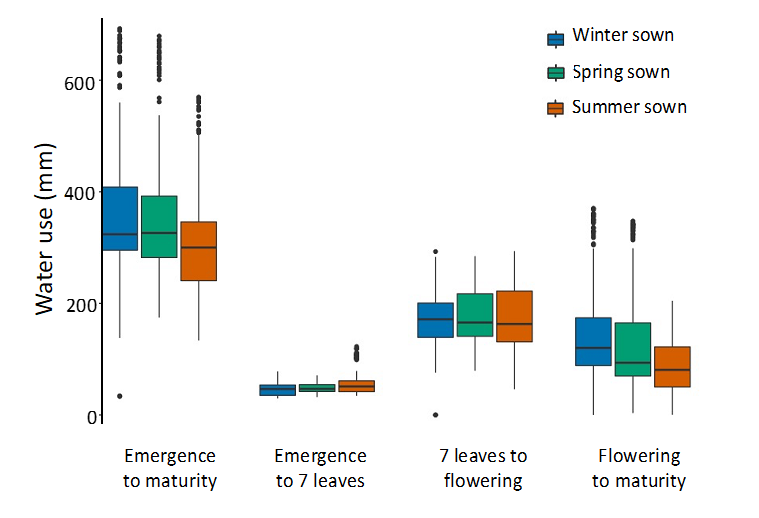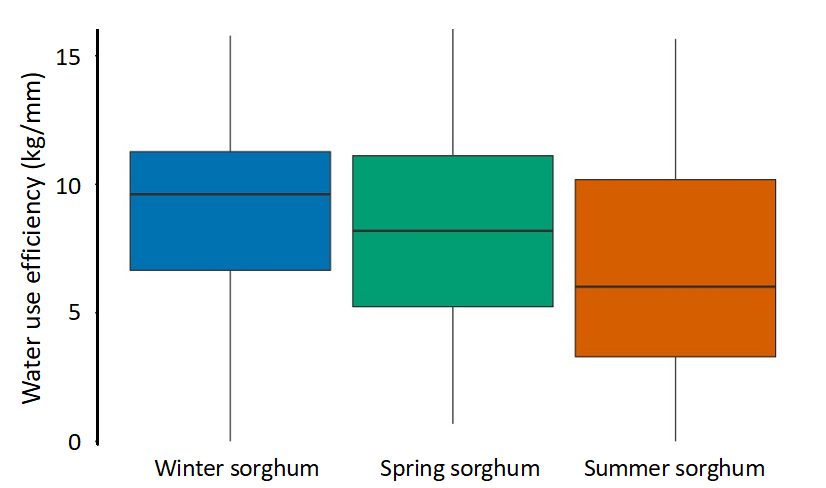Optimising sorghum agronomy & winter sown sorghum: water use and water use efficiency
Take home message
- Sowing early in late winter or early spring reduced the likelihood of heat stresses around flowering across most sites, at a very low risk of frost damage (after 7 leaves or floral initiation). Sowing sorghum in late summer also reduces the risk of heat stress, though at the expense of no double cropping, and an increased risk of frost damage in the southern sites
- Across all sites the yield of winter (very early) sown sorghum was similar or higher than sowing in spring and summer
- A winter sown sorghum will have a lower likelihood of a dry finish (terminal water stresses), which will reduce the potential for high screenings and minimise or eliminate lodging
- At the cropping system level there is an increased likelihood of double cropping after a winter sown sorghum
- Results from the analysis of two seasons of trials (2018-2020) across 15 sites from the Liverpool Plains in NSW to Emerald in Qld, showed that at each site the combination of hybrid, planting time and plant population created up to a 66% difference in grain yield and 8-fold differences in water use efficiency. This indicates that matching hybrid and agronomic management to site conditions should be important to farmers and consultants
- There are large gains to be made from informing optimum combinations of hybrid and agronomic management to site and expected seasonal conditions. DigitalAg applications that integrate information from multiple sources (e.g., networks of soil moisture sensors and seasonal climate forecasts that inform crop simulation models) need to be developed to better characterise site and expected seasonal conditions to inform the optimum combinations of hybrid and management within and across fields.
Summary
Early sowing of grain sorghum offers farmers the opportunity to increase; crop water use efficiency, the number of sowing opportunities cropping intensity and profits. Early sowing also reduces the risk of heat stress at flowering and terminal drought stress, reducing screenings and lodging.
Background
The main challenges of growing a profitable sorghum crop include avoiding periods of extreme heat around flowering and reducing the likelihood of water stress between flowering and grain filling. Australia’s climate has warmed by about 1.4 °C since 1910, and an increase in the frequency and intensity of extreme heat and water stress can be expected. Extreme heat at flowering causes pollen sterility that reduces grain numbers, the main determinant of final yield. In addition, water stresses during grain filling will increase screenings affecting grain quality. It may induce lodging. Options to ‘de-risk’ sorghum cropping involve avoiding the overlap of crop sensitive growth stages with the hottest and driest times of the year. We propose that sowing sorghum in late winter or early spring, can contribute to de-risking the impact of heat stresses around flowering and reduce the likelihood of terminal water stresses during grain fill. Benefits are likely to include an increased number of sowing opportunities, higher and more stable grain yields in some sites and seasons, improved grain quality and an increased cropping intensity by increasing the opportunity for double cropping of a winter crop after a short summer fallow.
However, for the practice to be promoted and adopted we needed to answer the question: ‘How cold is too cold to sow sorghum?’ Here we present the results from a winter sown sorghum program funded by GRDC and led by UQ-QAAFI, in collaboration with NSW DPI, QDAF and farmers from the Liverpool Plains in NSW to Central Queensland.

What have we learnt so far?
Early (winter) sown sorghum is unlikely to be damaged by late frosts in the Liverpool Plains or the Central Highlands. Sowing early in late winter or early spring reduces the likelihood of heat stresses around flowering across most sites, at a very low risk of frost damage i.e., frosts after 7 leaves or floral initiation. Sowing sorghum in late summer also reduces the risk of heat stress, though at the expense of no double cropping, and an increased risk of frost damage in the southern sites.
The yield of early (winter) sown sorghum was similar or higher than that of later sowing dates (Figure 2). This was associated to higher values of seed set due to a reduced incidence of heat stresses around flowering; and improved grain size (reduced screenings) due to increased availability of soil water later in the season.

The median total water use (emergence to maturity) of winter sown sorghum crops (324mm) tended to be like that of spring sown crops (326mm), though higher than that of summer sown crops (300 mm) (Figure 3). However, winter and spring sown crops tended to use more water later in the season between flowering and maturity, i.e., 120, 93 and 80mm, respectively (Figure 3).

The values of crop water use efficiency of winter sown sorghum tended also to be higher than those crops sown in spring and summer (Figure 4).

The higher water use efficiency of the winter sown sorghum crop was explained by the crop growing during a cooler time of the year (i.e., lower atmospheric demand), and a relatively smaller canopy size at flowering. Compared to the spring sown crop, this resulted in an additional 30mm of water used between flowering and maturity. This additional ~30mm of crop water use was responsible for the reduction in screenings observed in the winter sown crop (Figure 2).
Conclusions
In conclusion, the yield of winter (very early) sown sorghum can be similar or higher than sowing in spring and summer. A winter sown sorghum will have a lower likelihood of a dry finish (terminal water stresses), which will reduce screenings and minimise or eliminate lodging.
The increased water use efficiency of the winter sown sorghum means that additional water will be available during the grain fill stages, compared to spring or summer sown crops. However overall modelled water use was also slightly higher for winter sown crops, probably due to the extended growing season.
Acknowledgements
The research undertaken as part of this project is made possible by the significant contributions of growers through both trial cooperation and the financing of the GRDC. The author would like to thank them for their continued support. The authors also acknowledge the collaboration between QDAF, NSW DPI and UQ-QAAFI, participating technical staff and collaborating famers. Thanks also to the participating seed companies for their continued support.
Contact details
Daniel Rodriguez
QAAFI The University of Queensland
Ph: 0434 075 094
Email: d.rodriguez@uq.edu.au
Loretta Serafin
NSW DPI
Ph: 0427 3118 19
Email: loretta.serafin@dpi.nsw.gov.au
GRDC Project Code: UOQ1808-001RTX,
Was this page helpful?
YOUR FEEDBACK
